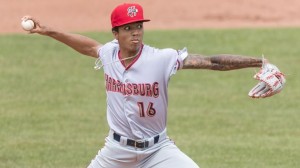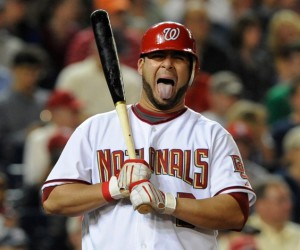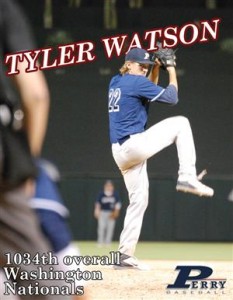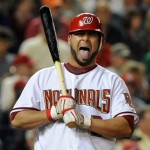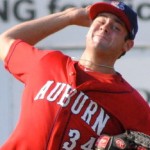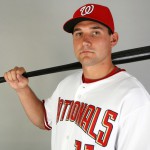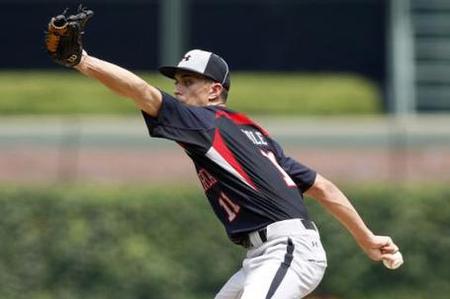
A comment about Mason Denaburg in the last thread, with MarkL wondering/speculating on whether our 2018 1st overall pick may possibly pitch in 2021, made me think, yet again, about the folly of drafting high school arms (or HS players in general) and then made me wonder..
Who is the best HS player we’ve ever drafted?
By “best” I mean possible one of two things:
1. Most successful for our team or for someone else, since (as we’ll see) we’ve had a tendency to trade prospects before they matriculate.
2. Most successful for the Nationals themselves.
So, we’ll answer both.
I’ll also divide this into the “Rizzo” era and the pre-Rizzo era, since you can almost count on one hand the total number of HS players Mike Rizzo has drafted since taking over in mid 2009, whereas the Jim Bowden regime was quite heavily skewed towards HS players.
Using the Draft Tracker as a reference, here are your nominees for best ever HS draftee by the Washington Nationals, moving backwards in time (note; i’m omitting some HS draftees like 20th round signees who happened to sign and subsequently flame out; this mostly is a value play of top-5 round picks plus other notables we over-paid).
- 2020: Samuel Infante, SS/3B from Florida: too early to tell obviously, but the reaction in the Natmosphere was mixed to begin with. We’ll see.
- 2018: Mason Denaburg, RHP from Florida. $3M signing bonus for getting selected 27th overall in the 1st round. Has been plagued by injury since his arrival, and his limited stats have not been promising. What is even more indicting about this selection is the fact that the next three arms drafted who signed ( Shane McClanahan, Jackson Kowar and UVA’s Daniel Lynch) were all college arms (like what the Nats normally draft this high), are all now considered top-100 prospects, and had all reached AA by the end of 2019. Opportunities lost.
- 2016: Carter Kieboom, SS from Georgia. Held the #1 Nats prospect label for years, but has struggled in two call-ups now that have the team looking at 3B candidates in free agency, a pretty severe indictment of what they think they have in Kieboom right now.
- 2016: Jesus Luzardo, LHP from Florida. Traded as the centerpiece prospect of the Sean Doolittle/Ryan Madsen acquisition in 2017, then became a top-10 prospect in all of baseball prior to the 2019 season. Pitched in Oakland’s rotation as a 22yr old in 2020 with league average results, projecting to be a #2 lefty starter. It was a lot to give up for relievers (at the time I was “ok” with the trade, but did note that it would look pretty lopsided if Luzardo turned into precisely what he’s projecting to become), but flags fly forever and Doolittle was an integral part of this team for a while.
- 2015: Blake Perkins, OF from Arizona. Traded to Kansas City as part of a prospect group to acquire Kelvin Herrera, has a career .236 minor league BA as a glove-first CF.
- 2015: Tyler Watson LHP from Arizona. 34th rounder paid like a 4th rounder that year. Traded to Minnesota to acquire Brandon Knitzler as part of the great mid-season bullpen construction job in 2017. Pitched all of 2019 in High-A’s rotation with decent results, likely in AA in 2021. Knitzler of course ran himself out of town in mid 2018, so the team didn’t get a ton to show for this trade.
- 2014: Jakson Reetz, C from Nebraska. Has passed through three Rule-5 drafts now and was part of the 60-man extended roster in 2020. He stepped up his power and his offense in 2019 in High-A; is he turning a corner? Re-signed as a MLFA this off-season to do his 8th pro season in our farm system.
- 2014: McKenzie Mills LHP from Georgia. This 18th rounder blew up in the spring of 2017, dominating Low-A and getting flipped to Philadelphia to acquire Howie Kendrick. His 2018 was solid in High-A, but he struggled with the jump to AA and got released in the minor league purge of June 2020. I wonder if he’s worth a MLFA flier in 2021 for someone.
- 2013: Drew Ward, 3B from Oklahoma. 3rd rounder who was good enough to get promoted year after year, but not to escape “org player” role. Released in the 2020 player purge.
- 2013: Travis Ott, LHP from Pennsylvania. showed some promise in his 2nd pro season in Short-A as a 19yr old, enough so to be the secondary piece in the huge 3-team trade that netted the team Trea Turner and Joe Ross. (more on that later when we talk about Souza). He continued to pitch well in Tampa’s org, but then curiously was moved to the bullpen in 2018 and then was stuck on the restricted list in apr 2019, where he presumably remains today. No idea what happened here.
- 2012: Lucas Giolito RHP from California. Perhaps the most controversial candidate on this list. He had TJ surgery the year he was drafted, recovered, raced through the minors and debuted for the team as a 21yr old in June of 2016. His Minor league career looked too good to be true. But, in MLB 21 innings that year he pitched to an ugly 6.75 ERA, an even worse 8.21 FIP … and then got flipped in the off-season as the centerpiece to acquire Adam Eaton from the White Sox. I hated the move when it happened. There were rumors about how the Nats talent evaluators thought that Giolito had “plateaued” or that somehow he wasn’t someone they could work with. And, to be fair, it took a full year of awfulness in the majors for the White Sox before Giolito modified his mechanics and turned into a pretty good starter. His last two seasons have been ERA+ of 134 and 128 respectively, and he’s gotten down-ballot Cy Young voting. Did the Nats give up on him too early? Yes. Did we get equivalent value in return from Eaton? No …. but it wasn’t entirely Eaton’s fault. Who could have known that Eaton would blow out his knee, which would blow out his defensive value, which was a huge reason he was such a WAR darling prior to his trade? Does the 2019 WS title make every move between 2015 and Nov 2019 worth it regardless of the transaction? Most would argue yes. Flags fly forever.
- 2012: Hayden Jennings, OF from Louisiana; a 6th rounder that year, he lasted just two years in the system and never got out of the GCL. Seemed like a quick release frankly; I wonder if there was some off-the-field issues.
- 2010: A.J. Cole RHP from Florida. Just could never cut it as a starter for this team, with spot start appearances across 4 MLB seasons for the Nats. Finally flipped for cash after his DFA ahead of the 2018 season when he ran out of options and the team ran out of patience. He’s bounced around since, pitching for the Yankees bullpen in 2018, getting claimed off waivers by Cleveland for 2019, then signing on as a FA for Toronto in 2020, each time putting up decent numbers as an 8th/9th inning non-closer type. Why he could never do this for us is … a mystery. Certainly we could use a competent reliever right now.
- 2010: Robbie Ray, LHP from Arizona. A 12th rounder given 2nd round money, Ray was the centerpiece prospect in the Doug Fister 2013 trade (which shocked the baseball world and made the Nats look like a genius), then was flipped again to Arizona ahead of the 2014 season. From there he turned into a solid starter, putting up huge K/9 numbers but featuring as a guy who struggled to get through 6 innings thanks to elevated pitch counts. He’s a FA this off-season and could be a decent 4th starter for someone.
- 2010: Bryce Harper: you could technically count Harper here since he was a HS-aged player in Juco, but it isn’t like selecting him 1-1 was any great piece of decision making on the Nats part. He was destined to be a 1st overall pick from the moment he appeared on the cover of SI as a 16-yr old.
So, in the Rizzo Era, I’d say that the most successful HS drafted player for us or any other team is clearly Lucas Giolito (even though Ray has more career bWAR), with Luzardo projecting right now perhaps as having the capabilities of supplanting him in the future.
The most successful HS drafted player for the Nats? Only three have even played a game for the Nats: Cole, Giolito and Kieboom. Read that sentence again; in a decade of drafting, just three prep-players have ever suited up for this team. I guess you’d have to say Cole has the most impact for the Nationals themselves at this point, with high hopes for Kieboom going forward.
Rizzo was named the GM in August of 2009, so technically the 2009 and prior drafts were not on his resume (yes he was involved in the 2009 draft, but it was still Jim Bowden‘s show) You can see the effect that Rizzo had on draft strategy, because prior to 2010, the team was much more apt to draft prep players. We’ll run through them below.
- 2009: Michael Taylor, SS from Florida. Quickly converted to OF, where he was a fantastic defender who hung around for years as 4th OF for the team. Finally non-tendered this past off-season, and he’s heading to Kansas City for the 2021 season. Some were sorry to see him go; if his arb salary hadn’t inflated so much, maybe he’d still be here.
- 2009: Roberto Perez SS from Puerto Rico. Played three minor league seasons and (in my opinion) got a quick release after a stint in 2011 at Short-A.
- 2008: Destin Hood, OF from Alabama. The 2nd round pick played out the string in our org, then bounced around for four more years as a MLFA. In his “make or break” year as a 23yr old in AA he slashed .224/.278/.327 and his fate was sealed. Eventually got some MLB time with Miami.
- 2008: Graham Hicks, LHP from Florida; never got out of low-A, flipped in the Gorzelanny deal, out of baseball by age 22.
- 2008: Adrien Neito, C from Florida. Had a great-looking season in High-A as a 23rd old, then the team left him unprotected in Rule-5 and he got plucked by the White Sox. I went back and looked at my analysis of the 2013 rule-5 draft and discovered that the team was sitting at 39/40 and really didn’t have the room to protect someone like Nieto, who was considered a long-shot to get taken despite going to the AFL that year. Nonetheless, after spending all of 2014 on the 25-man roster, he was went back down and never re-appeared. He has bounced around as a MLFA ever since and is still active today.
- 2008: J.P. Ramirez, OF from Texas. Ramirez played out his 6-years with the Nats, then jumped to indy and eventually Mexican league ball.
In 2007 alone, Bowden drafted no less than 8 prep players in the top 10 rounds. Did any of them pan out?
- 2007 Michael Burgess OF from Florida. He was beginning to blossom in 2010 as a 21 yr old, making it to AA and playing in the AFL, so he was used as the centerpiece prospect to get Gorzelanny. He didn’t do much afterwards, bouncing around orgs and eventually going to indy ball.
- 2007: Jake Smolinkski 3B from Illinois. Very quickly became a solid prospect, succeeding in Low-A as a 19yr old and became the centerpiece prospect sent that off-season to acquire Josh Willingham and Scott Olsen. Interestingly, he washed out of the Miami org as a MLFA, caught on with Texas and had several years as a MLB utility player with Texas and Oakland after that.
- 2007: Steven Souza, OF from Washington State: a middling prospect for years, he started to show some serious pop as a 23yr old in High-A, culminating with a blow-up season in AAA as a 25 year old that allowed the Nats to pull off perhaps their greatest ever trade heist; packing Souza with Travis Ott and interjecting themselves into a trade between Tampa and San Diego to fleece San Diego out of two first round picks in Trea Turner and Joe Ross. Souza had his best season in 2017 for Tampa, a 3.5 win team, but has struggled with injuries
- 2007: Derek Norris, C from Kansas. 5 seasons, 5 promotions for Norris in our system, before he was included as perhaps the 3rd piece of 4 in the Gio Gonzalez trade. Once he got to Oakland though, he blew up and had several solid seasons, even making the 2014 all star team. But he declined quickly, got moved to San Diego, then the nats re-acquired him back for Luis Avila … only to DFA him a few weeks later.
- 2007: Josh Smoker, LHP from Georgia. Played out his string with the team without ever getting out of A-ball, then made it into the Mets’ bullpen in 2016 and 2017, where he put up below replacement level numbers.
- 2007: Jack McGeary, LHP from Massachusetts. Paid like a mid-1st rounder in the days before bonus slots, McGeary seemed like a potential steal. Unfortunately, he just could not compete, suffering injuries multiple times. Mercifully taken in the minor league rule-5 draft by his hometown team Boston in 2013, he didn’t do much better there, eventually washing out of indy ball in 2014 as a 25-yr old.
- 2007; PJ Dean, RHP from Texas. Looked awesome in Short-A as a 19yr old, throwing 10 starts with a 1.97 ERA. Was the lead prospect in the Willingham/Olsen trade that off-season… then, nothing. I have no idea what happened to the guy; he never played another game of baseball for the Marlins or anyone. Does anyone have any idea what happened to him?
- 2007: Patrick McCoy LHP from Arizona; struggled as a starter early, moved to the pen, played out his string with the Nats as an org guy, signed on as a MLFA with Detroit and got a call-up where he put nearly 2.5 runners on base and was waived. Bounced around after that, never made the majors again.
It is notable that Jim Bowden nearly signed more HS players between these last two years than Rizzo has done in a decade in charge. Just a completely different mind-set of drafting.
In 2006 it was more of the same: the first 6 players he picked were all HS players.
- 2006: Chris Marrero, OF from Florida. Made his way up to the big club in 2011 as a 22yr old, never really made it back. Was the quintessential 4-A guy for years, profiling as a corner guy w/o great defensive skills but missing the big bat.
- 2006: Stephen Englund, OF from Washington State. Seems like a huge scouting miss; he just could not hit pro pitching. Career minor league slash line of .188/.308/.252. Cut from Low-A in 2009 after starting the season 11-101 with 48 Ks.
- 2006: Stephen King, 3B from Florida. Played for years in the low-minors as a light-hitting infielder, eventually leaving as a 6-yr FA. Got to AA twice, was never able to even hit .200 there.
- 2006: Colten Willems, RHP from Florida. The 1st rounder was ok his first couple of years in pro ball, never could really compete above low-A, then abruptly retired at age 21 when he struggled upon getting demoted back to Hagerstown. A huge draft bust.
- 2006: Sean Black, RHP from New Jersey. Drafted in the 2nd round, refused to sign. Went to Seton Hall, 7th round pick by the Yankees three years later. Was a solid starter up to AA, got flipped to Cincinnati and his career fizzled.
- 2006: Glenn Gibson LHP from New York. Had a great pro debut in Short-A as a 19yrold, then was traded to the Rays to obtain Elijah Dukes. Tampa dumped him two seasons later, and the Nats picked him back up because they liked him enough to draft him in the first place. He didn’t go much further and was released from affiliated ball in 2011 as a 23yr old.
- 2006: Sam Brown, RHP from North Carolina. Did not sign, went to NC State, signed with Texas, then signed as a MLFA with the Nats in 2011 after his release. Pitched one year in the Hagerstown bullpen and was done.
- 2006: Brad Peacock, RHP from Florida. A 41st round pick selected under the previous rules of “Draft and Follow.” He was drafted in June of 2006, but not signed until May 30th of 2007. It took him a while to get going professionally, but he blew up in 2011, rising from High-A to the majors with a sterling debut. This led to him being included in the player package to acquire Gonzalez from Oakland. After a year there, he was moved again to Houston in the Jed Lowrie move, and from there he flourished in a swingman role, winning a World Series there in 2017.
In 2005, just one top-10 round HS player drafted, but a few more signed on in the later rounds.
- 2005: Ryan DeLaughter; OF from Texas. he never really succeeeded outside of complex ball, giving Short-A a try multiple times. Hooked on briefly with Milwaukee and indy league baseball as a 22yr old.
- 2005: Deryck Johnson, CF from Florida; this 14th rounder played just one season in rookie ball, hit .185 and was cut.
- 2005: Michael Watkins, RHP from Rhode Island. Pitched parts of two rookie league seasons and got cut.
- 2005: Eduardo Pichardo, RHP from Florida. This 17th rounder threw 13.2 innings across two rookie league seasons and posted a stellar 20.41 ERA and was released.
- 2005: Brad Clark, RHP from Florida. This 19th rounder got hurt, didn’t pitch until 2007, threw 5 1/3 total innings and got cut.
- 2005: Ryan Butchter RHP from New Jersey: signed as a 33rd rounder, somehow survived two seasons with ERAs north of 7.00, then got traded after his third pro year for Matt Avery. Avery pitched one year of relief for our AA team and got cut. Meanwhile, Butchter hung on for years, finally debuting as a 27 yr old, and then as a 29yr old rookie excelled in the San Diego bullpen.
So, in the pre-Rizzo era, who’s the most accomplished HS drafted player for any team? Best candidates are Peacock, Norris, Souza, and Taylor. I’ll go out on a limb and say its Peacock.
For just the Nats? Has to be Taylor.
